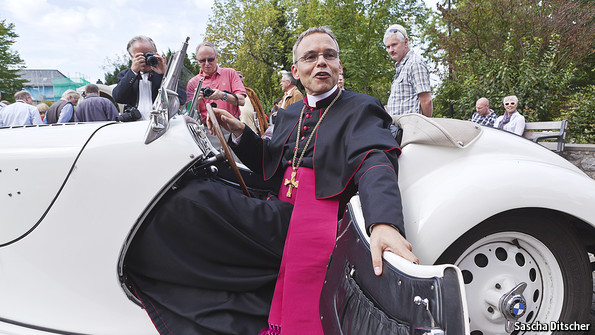Bishop of Bling
The Economist
THE faithful of Limburg, a diocese in Hesse, have been protesting in front of their Romanesque cathedral, a few even affixing “95 theses” to its door to make their views of their bishop unmistakable. But the prelate, Franz-Peter Tebartz-van Elst, had already gone to Rome, where he awaits a meeting with Pope Francis that will determine his future. The extent of his excesses is such that it is hard to say which detail most rankles Germans, and not only Catholic ones. For some it is the petty lying. Last year the bishop flew first class to India to look at some do-goody projects. But when Der Spiegel, a news magazine, confronted him, he insisted that he had flown business class, even signing affidavits. On October 10th prosecutors in Hamburg indicted him for perjury. For others it is the pomp and luxury. In 2010, two years after he became Germany’s youngest bishop at the age of 48, Bishop Franz-Peter began building a new residence next to the cathedral. The cost was estimated at ˆ5.5m ($7.43m). Then his requests piled up. His bathtub cost ˆ15,000. Instead of resting an advent wreath on an iron frame in his chapel, he wanted it suspended from the ceiling, requiring the roof to be cut open, at a cost of ˆ100,000 instead of ˆ10,000. In total, the cost estimates now run to ˆ31m. Germans usually expect to read about such clerical ostentation in history books about the Reformation. Pope Francis, who has chosen simplicity and modesty as his message, makes the incongruity even starker. In an increasingly secular Germany this latest scandal is disastrous for the churches. Germany separates church and state much less clearly than does America but more explicitly than Anglican Britain or Orthodox Greece. Its post-war constitution, in a clause carried over verbatim from the Weimar constitution of 1919, favours no particular faith but lets all churches levy taxes on their members through the income-tax system (8% or 9% of a taxpayer’s bill, depending on the state). The state also finances churches directly. It still compensates them for expropriations dating back to 1803, when Napoleon demanded war reparations from German princes. With this money the churches take on more tasks than in many other countries. One hospital in three, for example, is run by a church, as are many creches and schools. The churches are Germany’s second-largest employers (after the government). This has drawbacks, says Eva Muller, author of a book critical of the system. A Catholic-run creche, say, can fire a teacher who divorces and remarries, even though no secular German institution may do so. In one egregious case last December, a woman who had been raped was refused treatment by two Catholic hospitals because abortion was one option. Aside from public funds, many churches also have half-hidden pots of money to play with. Bishop Franz-Peter, for example, built his compound with money from an endowment set up by a duke of Nassau two centuries ago. Hardly anybody knows what assets are in it. The churches urgently need to make such things transparent, argues Thomas von Mitschke-Collande, a former consultant at McKinsey who has written another critique of Germany’s Catholic church. In the meantime ever more Germans respond by severing their affiliation with institutionalised religion. Church attendance, weddings and baptisms are all declining. The exodus would be faster still but for the many Germans who remain church members for pragmatic reasons, such as sending children to a church school. Even so, more than 100,000 Germans leave the Catholic and Protestant church every year. In Limburg exits usually run at one or two a day, but have now jumped to about a dozen.
|
.
Any original material on these pages is copyright © BishopAccountability.org 2004. Reproduce freely with attribution.
